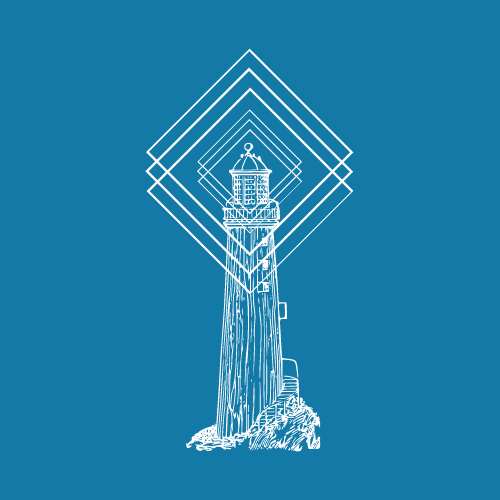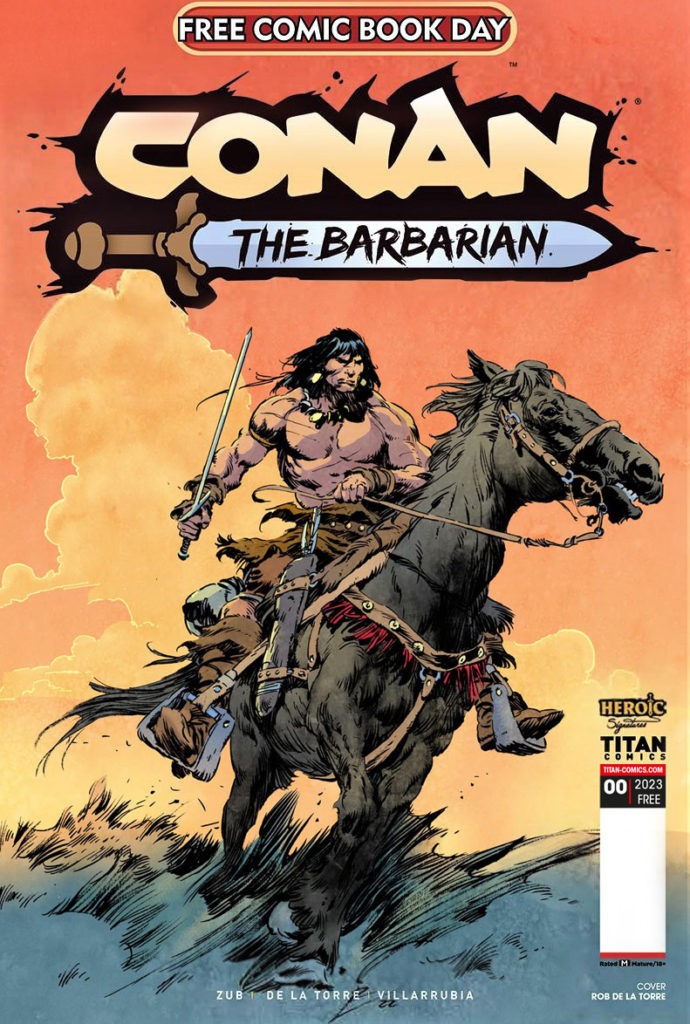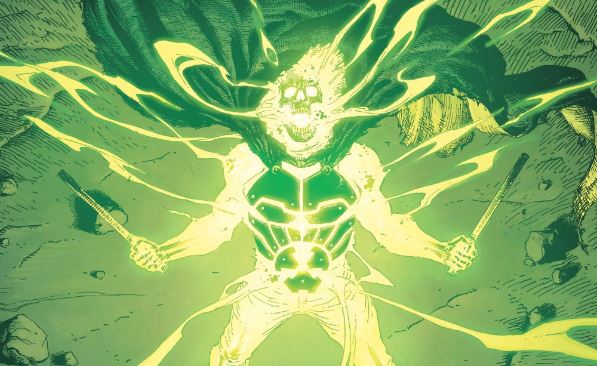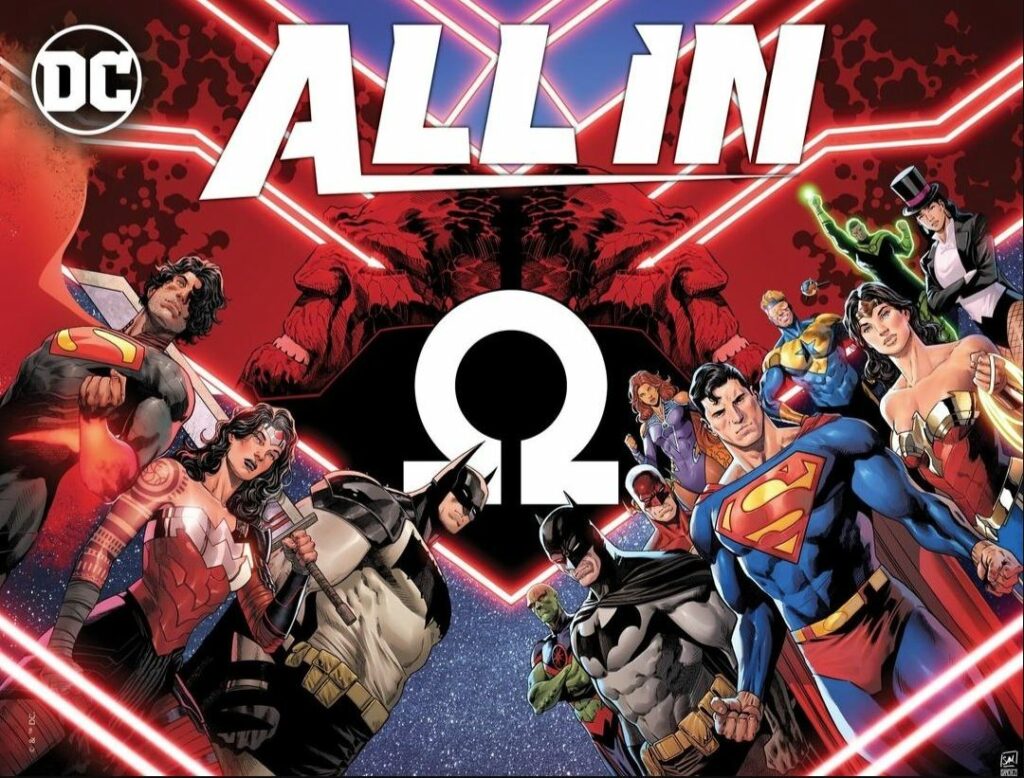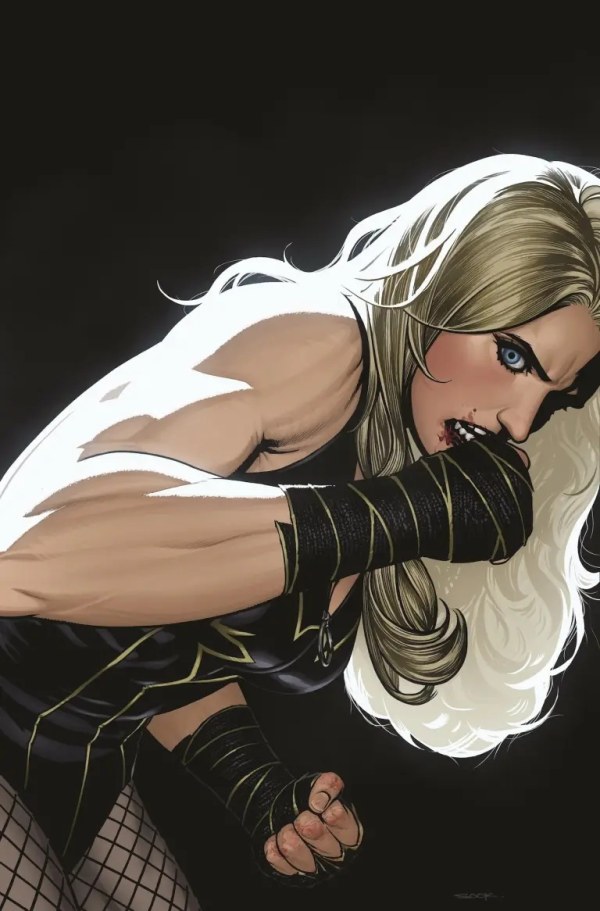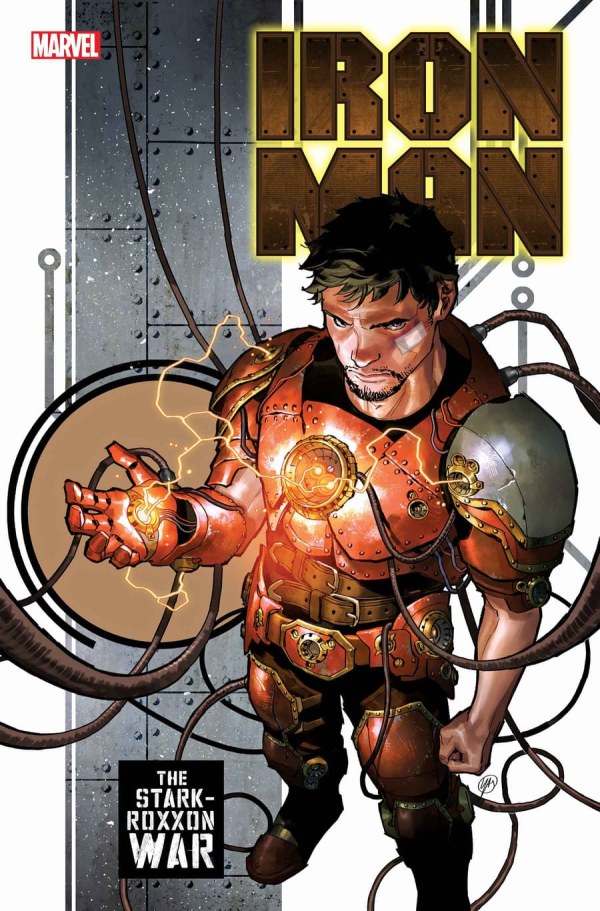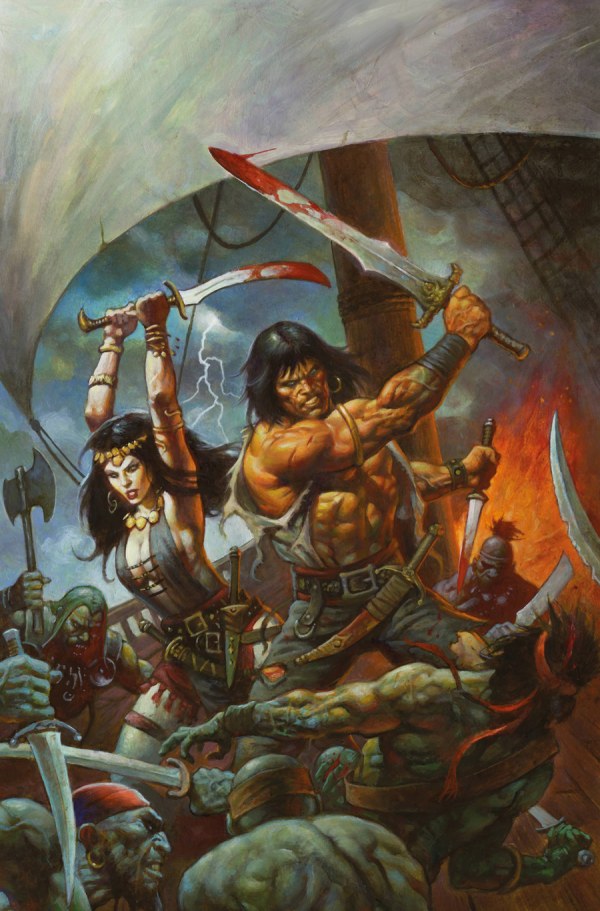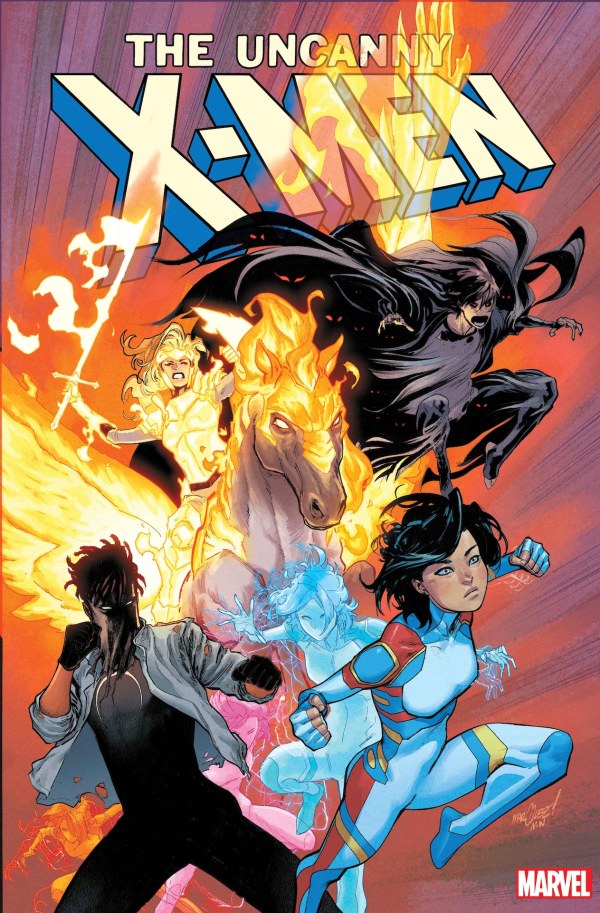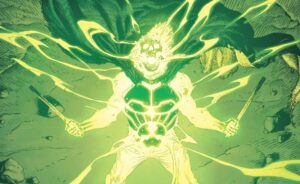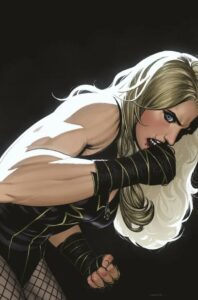Setting the stage for any new series is a challenge; re-introducing readers to a character and world over 90 years old is another feat altogether. That is the task set before newest Conan the Barbarian scribe Jim Zub, joined by creator-in-arms Robert De La Torre.
For the past few years, Marvel Comics has been in possession of the licence to the publishing rights for the muscle-bound Cimmerian. In that time, they’ve reprinted a myriad of collections, reprinting classic tales, and even launched some new ones. Everything from tales set in the Hyborian Age, to multiversal team ups between Conan and our favourite caped crusaders in titles such as Savage Avengers. At least, they were publishing these stories. That all changed at the end of 2022.
With the rights now being licenced to Titan Comics, a new age of Conan comics is being heralded. This time, writer Jim Zub (previous Conan writer at Marvel, returning once again to his favourite sword and sorcery icon) is charting the future of Conan’s adventures, and it’s all been set up in this year’s Free Comic Book Day (FCBD) issue Conan the Barbarian #0.
What’s remarkable about this instalment is that Zub and De La Torre don’t just set out to craft good marketing. It would be easy to wheel out some classic Conan villains, render some epic battles and give readers a glorified trailer of events to come.
Instead, the team tell a genuine, meaningful tale that sits comfortably within Conan canon, previews the character and tone of the forthcoming series, and illustrates the sorts of themes that underpin the essence of the property. They understand the potential of a prologue like this so well, that the very nature of the storytelling on display here underscores the moral and conceptual quanadries that has kept the titular barbarian feeling accessible and relatable for decades of publication history.
Enter Conan the Barbarian: “Looking for Lands Beyond”
Zub and De La Torre’s Conan is a story of place. More than the blood, and the swords, and the battles and the rogue antics, Conan the Barbarian is chiefly concerned with telling a story about place.
The opening page of the FCBD issue is a passage from the Nemedian Chronicles. Throughout this excerpt, littered with references to ‘Atlantis and the gleaming cities’ and ‘shining kingdoms lay spread across the world’, Zub et al make one thing clear: the life of Conan is epic in scope, and is made epic not just by his actions but by his presence across and amongst the world.
Conan is, after all, a simple man – ‘a thief, a reaver, a slayer’ the Chronicles read. If one were to take away the sheer volume of bloodshed and doom that he manages to evade, they might begin to wonder what it is that separates him from the next barbarian. In the opening story presented here, Conan is but one of many souls fighting to prevent the sacking of Venarium. He is, prowess aside, remarkably ordinary. And yet as readers, we know he is destined for greatness. So, why Conan? Why do we not follow anyone of his surviving companions in their subsequent adventures instead?
‘With gigantic melancholies and gigantic mirth,’ the end of the Chronicles reads, Conan will ‘tread the jeweled thrones of the Earth under his sandalled feet’. This line conjures forth a pair of dichotomies, a vast emotional landscape and a vast social landscape, separated by great distances, brought into contact by Conan’s very being. Through his exploits, Conan – a man already bridging two vastly different emotional realities within himself – will collapse the space between the loftiest of kings and the lowliest of peasants, alluded to by ‘jeweled thrones’ and ‘sandalled feet’ respectively. Therefore, before we even meet Conan, we can begin to infer that he is a man bound up with ideas of movement, and displacement.
The next page goes on to reinforce these ideas, entreating the reader to a map of the world and its kingdoms: Cimmeria, Zingara, Koth, Aquilonia and, encircled in red, Venarium – setting stage to the FCBD issue’s events.
The Sacking of Venarium, An Analysis of Space, Place and Time
The first thing to highlight is the framing of this story, both literally and visually. As Jeffrey Shanks notes in an afterword to this issue, the sacking of Venarium marks the ‘first significant event of [Conan’s] youth […] his baptism of blood’. On a surface level, this helps to orient the reader – the job of any good zero issue – as it situates us in sync with Conan. Both parties at the start of their journeys within the Hyborian Age.
On a subtextual level however, it further drives home that importance of place within Conan’s adventures. It was not a random brawl on the side of a nameless road that gave birth to Robert E. Howard’s pulp icon. It was a specific encounter, in a specific place. One that, as Shanks also notes, Conan will return to in later life, that time working with the Aquilonians that he is currently at odds with here. Certain places have gravity within Conan the Barbarian’s life, causing him to orbit and return to them as time progresses. In that way they act a little like lenses. Through Venarium, the reader can see Conan in different lights.
Visually speaking, there is also another layer of framing to unpick. Both the first panel under De La Torre’s pen and the last are of these evocative, far-off vistas. In the opening, we see the heights of Venarium castles breaching through the night sky. By contrast, the closing page sets Conan small against mountainous, snowy ranges, crowned with the break of dawn. This creates a few interesting effects.
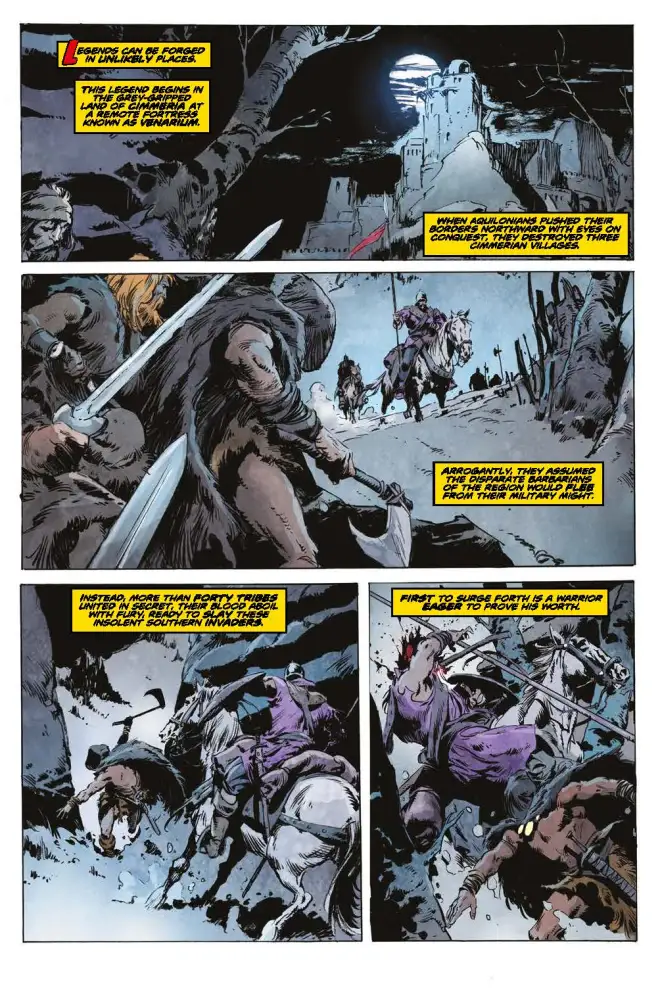

First, this framing device serves to bookend the narrative within these images of place. Conan the Barbarian’s story, as it is presented here, is always contained within a question of location. It is not enough that he repels marauders; that does not reveal anything of note about him. Rather, he is specifically repelling invaders. This leads to an interesting juxtaposition of opposites once again where, barbaric as he may be, there is also a nobility to Conan. He, draped in a loin cloth and fighting the colonial advances of civilisation, repels the Aquilonian force.
At once presented as a conflict of the savage vs the civil, Zub and De La Torre take what is, on the face of it, a simple skirmish and immediately start complicating things. For one, in this binary, the barbarians are framed as the protagonists – upending the typical framing that the ever-encroaching influence of civilisation is a good thing. Instead, the Aquilonians are characterised as ‘arrogant’, driven by ‘conquest’ to ‘destroy three Cimmerian villages’. This is not the benevolent, liberating face of civilisation that colonial powers would project – this is the savage reality. Suddenly, the distinction between the two opposites is muddied. Furthermore, the actions of Conan, supposedly a barbarian, is more in line with that of a knight, conjuring all the subtextual implications bound up in such an idea. Even the cover to Conan the Barbarian #0 invokes that image – as the titular hero rides towards the reader atop horseback, battle-ready but not thirsty for blood.
By framing this issue as a story that begins and ends with images of place, of civilisation, readers are again made to view Conan through a particular lens. The young Barbarian’s adventures are not, as they may initially appear, a ballad of heroism in the face of simplistic evil. This is not a pulp morality tale. Rather, this framing helps suggest that Conan the Barbarian figures as more of an aperture for the series’ wider exploration, not of good vs evil, but of civility vs savagery, and whether that binary is much of a binary at all.
This is a story that opens and closes not with a depiction of a place’s people, but with a people’s place. And if we are to take that in conjunction with the premise that Conan is something of a displacer within the narrative – the idea that his being shortens the distance and complicates the relationship between previously fixed and opposed states (mirth and melancholy, jewels and sandals, and now civilisation and barbarism) – then we start to see another part of the character’s core conceit emerge.
Conan the Barbarian’s story is not just one of place, but one of how the ideas around place, around culture and belonging and civilisation, are filled with false dichotomies.
The second effect of this framing is one that moves away from the geographic and toward the temporal.
As stated, the story opens on an image of Venarium at night and closes on one of snowy mountains at dawn. Whether we are to believe that the events described actually occurred over one night are irrelevant – the visual imagery conveys that suggestion. Moreover, it frames the plot of the issue as being captured within one episode of time, specifically within the transition from night to day. This does two things: one, it reinforces the feeling that this is, like all Conan’s adventures, something of a day-in-the-life. It is significant, but it is common. Two, by placing this within such a liminal timeframe, it highlights the cyclical nature of events like these. Conan the Barbarian will return to Venarium, to these questions of civility and savagery, as naturally and certainly as twilight turns to day.
Conan’s Place on the Page
Moving from the shape of the piece to the contents of it, Zub, De La Torre and colourist Jose Villarrubia play with ideas of place in practically every panel. This is true of things as small is in-panel details, all the way up to full-page panel composition. Case in point, take page three (shown above). There’s a couple really wonderful techniques being employed by the art team to quickly acclimatise the reader both to the narrative set-up and also to language of the page itself.
Villarrubia makes the subtle yet significant choice to colour the Aquilonian forces in purple, separate to Conan and his warband. Not only does this serve to visually distinguish the two parties – an important shorthand when introducing readers to a messy conflict in media res – it also helps orient the reader. By highlighting the Aquilonians like this, with one bold block colour that would not otherwise be found in these scenes, it’s easy to scan the page. Based on how much the Aquilonians occupy each panel, or whether they’re central in them or pushed towards the gutters, one can easily ascertain whether Conan is in a position of triumph or danger without having to struggle with the layout.
Another great technique on display here is the blocking within the panels. In panel two, Conan the Barbarian’s group sit in the foreground, the “camera” perched beside them as both they and the reader spy the Aquilonians traipsing through the path. Not only does this closeness with the barbarians help align the reader with them off the bat, it also makes the impending action feel incredibly personal. De La Torre doesn’t frame events from some artificial birds-eye view that we the reader could never be in – he keeps things grounded, in the moment and the tension. Were these barbarians heavily inked and covered in shadow, one might take this panel to instil a sense of dread, as the wandering soldiers are unaware that they’re about to be set upon. However, by ensuring they are as lit as the purple-clad warriors they’re watching, the atmosphere shifts from one of dread to anticipation.
Then, in panel three, De La Torre employs another clever piece of blocking – this time inverting the perspective, situating the “camera” with the Aquilonians as a hooded Conan emerges from the shadows, axe held high. What’s remarkable about this is that even though the Aquilonian should command the panel, now being the largest presence within it, Conan is situated at the tip of a v-shape, born out of a break in the mountain. It acts almost like an arrow, pointing the reader’s eye directly to Conan. It doesn’t matter that he’s the smaller, visually weaker force – the page is dictating where the emphasis of the moment lies.
In this way, Conan interacts with place in two senses: the first within the construction of the panel itself, as described, and second with the world within the scene. With the contours of the mountain drawn as such that they announce Conan’s arrival, then it can be read that the world around Conan is bending to support his status. If, as outlined earlier, certain places have a gravity that affects Conan, then he himself also has a sort of gravity that affects them in turn – like some narrative symbiosis where one empowers the other.
The final panel of this page caps off this series of events as a kind of punctuation mark, echoing a visual rhythm that Hassan Ostmane-Elhaou outlines in Vol. 1, No. 4 of Panel x Panel as an ‘intro, set-up, punchline’ structure. Usually reserved for discussing applications of the nine-panel grid, that same format applies here, as the introduction, emergence and attack of Conan works so well due to following this framework.
Turning the page, the reader is then greeted with the first face-on image of Conan the Barbarian.
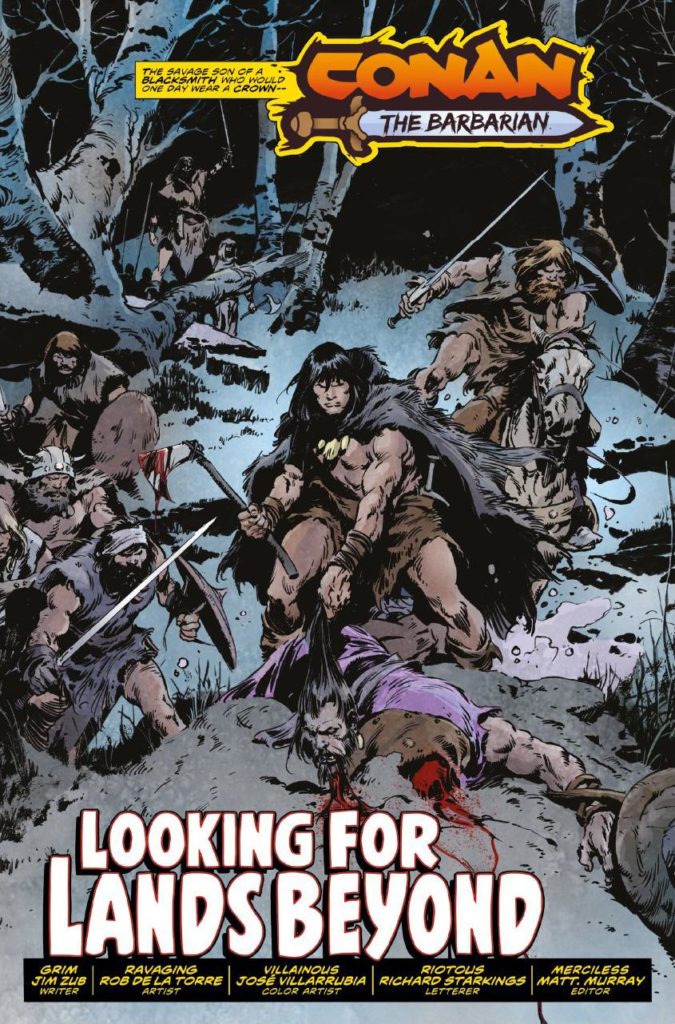
Notice how, now that Conan is known to us and he is at his most powerful, he occupies the centre of the whole page. The beheaded corpse of the Aquilonian even acts as another kind of arrow, drawing the reader’s eye back to the page’s centre.
Zub and De La Torre define Conan in this moment. In particular, they define who he is when he’s at his truest: powerful, violent, but not gleefully so. He is a warrior yes, and a savage sword at that, but he doesn’t revel in the bloodshed. He is also characterised as a slayer of those who’d mean the less powerful harm, and he is a man surrounded by others. The use of place on the page suggests that Conan the Barbarian is not a loner at his core, despite the lonesome travels that litter his stories. He is a man of people, who is looking to belong within something.
Composing the Barbarian(‘s Pages)
Perhaps one of the most interesting uses of the comics form to convey the relationship between Conan and various senses of place comes in page seven.
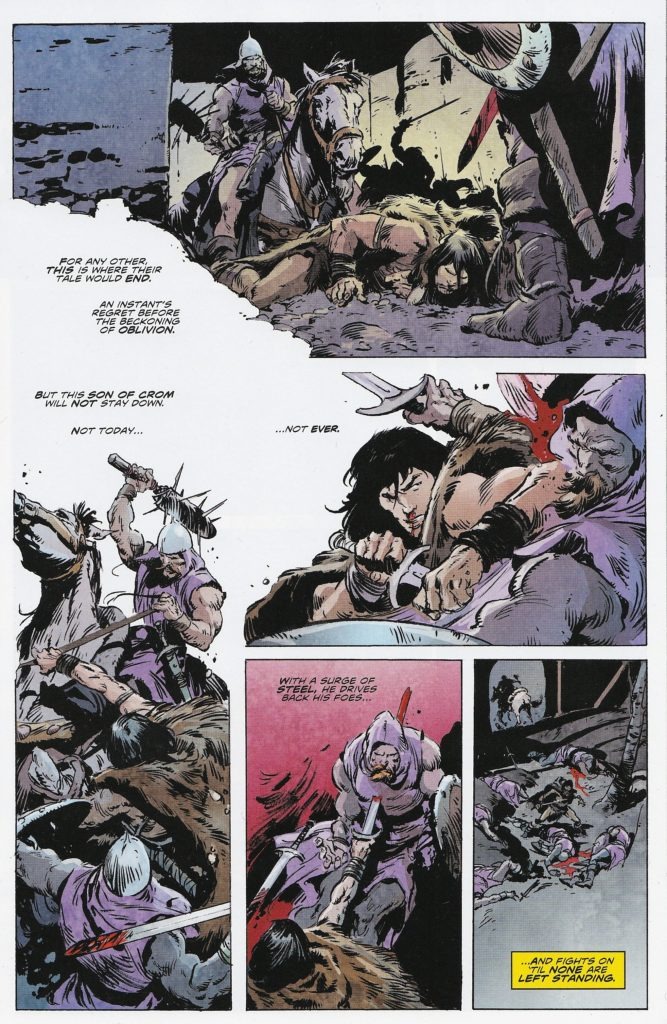
This page marks a turning point in the battle, as Conan is wounded during the fight and lays battered on the floor. While he gets his bearings, and the lucky Aquilonian approaches his prey, the narrative captions become unmoored from the panels. Rather than overlaying the images as they have done for most of the book, they now move on this page to exist in the gutters – the white space between the panels. It adds to a sense of narrative distance, as even Richard Starkings’ lettering is moved outside events as the antagonists look to remove Conan from proceedings.
Coupled with large panels that help let the moments breath, inviting the reader to spend longer processing them than others before, the creative team brilliantly manipulate the allotment of place on the page to in turn manipulate the reader’s emotions. “Is this really the end? Will Conan, too, soon leave the narrative, just like the narration that’s slipping away?”
Of course, Conan is not defeated so easily – just as all seems dire, the barbarian reasserts his primacy both within events and on the page, as he plunges his sword through the Aquilonian’s breast.
This reorientation of place and, by extension, power within the narrative is underscored by two things. The panel bleeds red in the background, distinguishing it from the rest of the page and selling the idea that Conan will violently realign his place in the world if he’s found wanting. Additionally, this also marks the first panel on the page where the narration is no longer set against the white space of the gutter. This is his story once again, a story in which he is the driving agent.
The following pair of pages feature plenty worth discussing too, but for now I’ll simply draw attention to the fact that every panel depicts Conan looking away from wherever he is. Whether that’s directly toward the next panel, or the next person of interest, or the next piece of loot, he seems remarkably uninterested in whatever place he currently finds himself.
Connoted within this is that: a) Conan’s goal, unlike the Aquilonians, is not one of conquest, and his interest in place is never to own or change it, merely be in it and b) he is constantly searching for somewhere to settle and be fixed.
Indeed, it is only upon finding a sword whose ‘markings are unknown to him but suggest substance and legacy’ that Conan finds renewed purpose.
The next two pages entreat the reader to a gorgeous double page splash of Conan’s future adventures – but once again, this functions not just as some superficial trailer for issues to come, but rather as a vital part of Conan the Barbarian #0’s thematic exploration of place. Conan’s destiny, as portrayed here, is both fixed and fluid. He’s a man defined by his kingdom, but his kingdom constantly changes. An eternal traveller, constantly venturing forward, toward a home he’s never known but knows exists, somewhere.
To Zub’s credit, this also serves as a perfect encapsulation not just of the title’s hero but of the draw and catch of serialised fiction altogether. The journey is always second act – as readers tune in every month on the promise, or hope, that there’ll be another adventure waiting for them the month after even though they’re yet to complete this one. We, like Conan, are always ‘looking for lands beyond’.
Returning to Where Things Began
If #0 is anything to go by, Conan the Barbarian will prove to be a masterful, layered read under Zub, De La Torre and co.’s reign. Their Conan is clearly a story as much about how a sense of place relates to Conan as it is about Conan’s exploits themselves.
The team have succeeded in utilising their FCBD outing to excavate many of the core themes of the character – the dichotomy between civility and savagery among them – while putting a fresh, new spin on things. Conan, as Zub et al suggest, is a story about the complexities of cultural ideas of belonging, a story about travellers noble of heart if not status, who reject conquest and find strength in their common man. It is a story told with an immaculate eye for the craft of storytelling, that understands place can be found within and on the page itself.
At it’s core, Conan’s story is one of searching, as he travels from the highest peaks to the lowest caverns yearning for that elusive sense of belonging. Of home. The irony of which being, he’s already found it. On page four, in that simple, familiar scene of Conan the Barbarian, his enemy slain at his feet, his kinsmen flanking all around – that is the sense of certainty the character yearns for. The fleeting moment where he is not savage nor civilised, a hero nor a villain – where he’s simply a man comfortable at the centre of his world, triumphant and content in the ordinary quality continual being.
Conan the Barbarian’s place in the world is in the heart of adventure.
